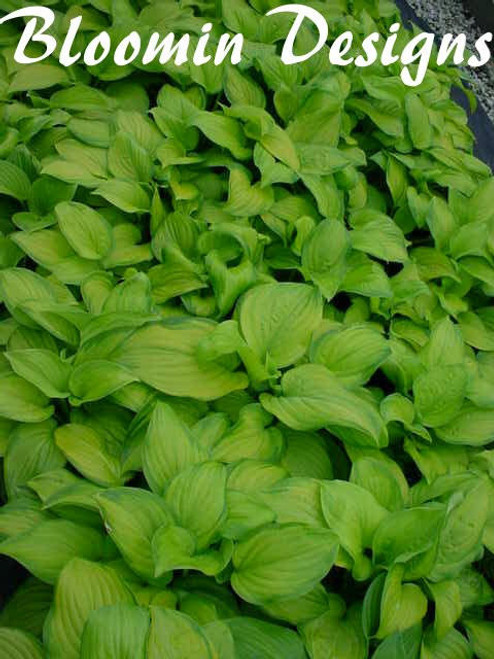Product Description
Hosta 'August Moon' (Ruh 1996) (25) bare root clumps
- Large, heart-shaped leaves are bright gold to chartreuse depending on the amount of sun exposure
- They are corrugated, wavy, and of good substance making them slug resistant
- Tolerates full sun which will intensify the gold color of the leaves
- Pale lavender, open bell-shaped flowers are prolifically produced on 24' scapes in mid to late summer
Medium to Large.
Large rounded, wavy, corrugated leaves.
Yellow gold with slightly rippled margins.
mound-like with moderate to fast growth rate.
Off-white flower.
This classic needs a little sun to mature to best glowing gold colors.
Lightly wavy, moderately corrugated, nearly round leaves with prominent veins; scape has inflorescence leaves.
American Hosta Society President's Exhibitor Trophy -- 1978
Height:20 Inches
Spread: 42 inches
Scape Height: 24 Inches
Hardiness Zones: 3,4,5,6,7,8,9
Flower Color: Purple shades
Foliage Color: Yellow shades
Full Sun to Full Shade
Average to Consistent Water Needs
Average to Fertile Soil Quality
Bloomtime: Midsummer to Late Summer
Attracts Hummingbirds
Growth Rate: Medium
Border Plant, Mass Planting, Cut Foliage, Easy To Grow, Edging, Attractive Foliage, Specimen, Focal Point
Illuminate Your Shade Garden with the Luminous 'August Moon' Hosta!
Hosta 'August Moon' is a beloved and widely grown hosta cultivar that brightens up shady gardens with its large, heart-shaped, golden-yellow leaves. This vigorous and adaptable perennial forms a dense mound of foliage, adding a touch of sunshine to even the darkest corners of your landscape.
'August Moon' is a classic hosta known for its vibrant foliage and sun tolerance. Its large, heart-shaped leaves emerge chartreuse-green in spring and mature to a beautiful golden-yellow, especially when exposed to some morning sunlight. The leaves have a slightly puckered texture and prominent veins, adding further interest. In mid to late summer, the plant sends up tall, slender scapes bearing clusters of pale lavender to white, bell-shaped flowers, adding a touch of elegance to the display. This hosta is a reliable grower and requires minimal care, making it a favorite among gardeners of all levels.
- Mature Size: 20 inches tall, 42 inches wide
- Foliage Color: Chartreuse-green, maturing to golden-yellow
- Flower Color: Pale lavender to white
- Bloom Time: Mid to late summer
- Growth Habit: Mounding, clump-forming
- Light Needs: Part shade to full shade (tolerates some morning sun)
- Soil Needs: Fertile, moist, well-drained soil
- Hardiness Zones: 3-8 (USDA)
- Special Features: Large leaves, vibrant color, sun tolerant, attractive flowers, low maintenance
Planting:
- Timing: Plant in spring or fall for best results.
- Location: Choose a shady or partially shaded location with fertile, moist, well-drained soil. 'August Moon' can tolerate some morning sun, especially in cooler climates, but avoid harsh afternoon sun.
- Soil Preparation: Amend the soil with compost or other organic matter to improve drainage and moisture retention.
- Spacing: Space plants 3-4 feet apart to allow for adequate growth.
- Planting Depth: Plant the crown (where the leaves emerge from the roots) at the same level as the soil surface.
- Watering: Water thoroughly after planting and regularly until it is established.
Care:
- Watering: Hostas prefer consistently moist soil. Water regularly, especially during dry spells.
- Fertilizing: Apply a balanced fertilizer in spring to promote healthy growth and flowering.
- Mulching: Apply a layer of mulch around the plants to retain moisture, suppress weeds, and protect the shallow roots.
- Pruning: Remove any faded or damaged leaves throughout the growing season. Cut back the flower stalks after blooming to encourage foliage growth.
- Pest and Disease Control: 'August Moon' is generally pest and disease resistant, but watch for slugs and snails, which can damage the foliage.
Uses in the Garden:
- Shade Gardens: Ideal for adding a bright and cheerful touch to shade gardens.
- Woodland Gardens: Thrives in woodland settings, complementing other shade-loving plants.
- Borders and Edging: Creates a beautiful border along walkways or flower beds.
- Groundcover: Can be used as a groundcover in shady areas.
- Containers: Can be grown in containers, adding a touch of elegance to patios and balconies.
- Mass Plantings: Plant in groups for a dramatic display of golden foliage.
Brighten your shade garden with the luminous foliage and easy-care nature of Hosta 'August Moon'!
Other Details
The most important part of the plant is its root system. Healthy roots are the foundation of a healthy, vibrant plant. The type of plug container used is based on the specific needs of the plants. Perennials offered as bare root traditionally perform better when planted as bare root.Planted in a specialized mix, potted plants have well established root systems. Top growth stage will vary depending on the current life cycle and time of year when shipped. In Winter and early Spring dormant plants may be shipped. Dormant plants may be planted right away, even before the last frost date.
Most bare root varieties are field grown for at least one season, though Hemerocallis and Hosta are grown for two seasons. The bulk of the soil is removed during the harvesting process and the tops of most varieties are trimmed back to the crown. They are graded, packed in shredded aspen or sphagnum moss and stored in freezers until ready to be shipped.
See our Container Sizes and Bare Root Perennials pages for more information.
Plant information and care is provided in the Overview section, Plant Genus Page and general information is provided in the Planting Care & Guides. Additional questions can be asked on each Plant page.
Plant Spacing: Using the maximum mature spread or width of a plant to guide spacing, ensures space to grow to full size. To fill an area sooner, plant them closer together. Just remember, future thinning or transplanting may be needed.
Water: Keep a close eye on newly planted perennials, especially throughout the first growing year. Most early plant loss is due to too much or too little water!

















